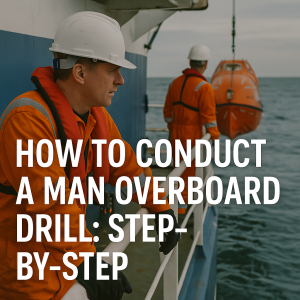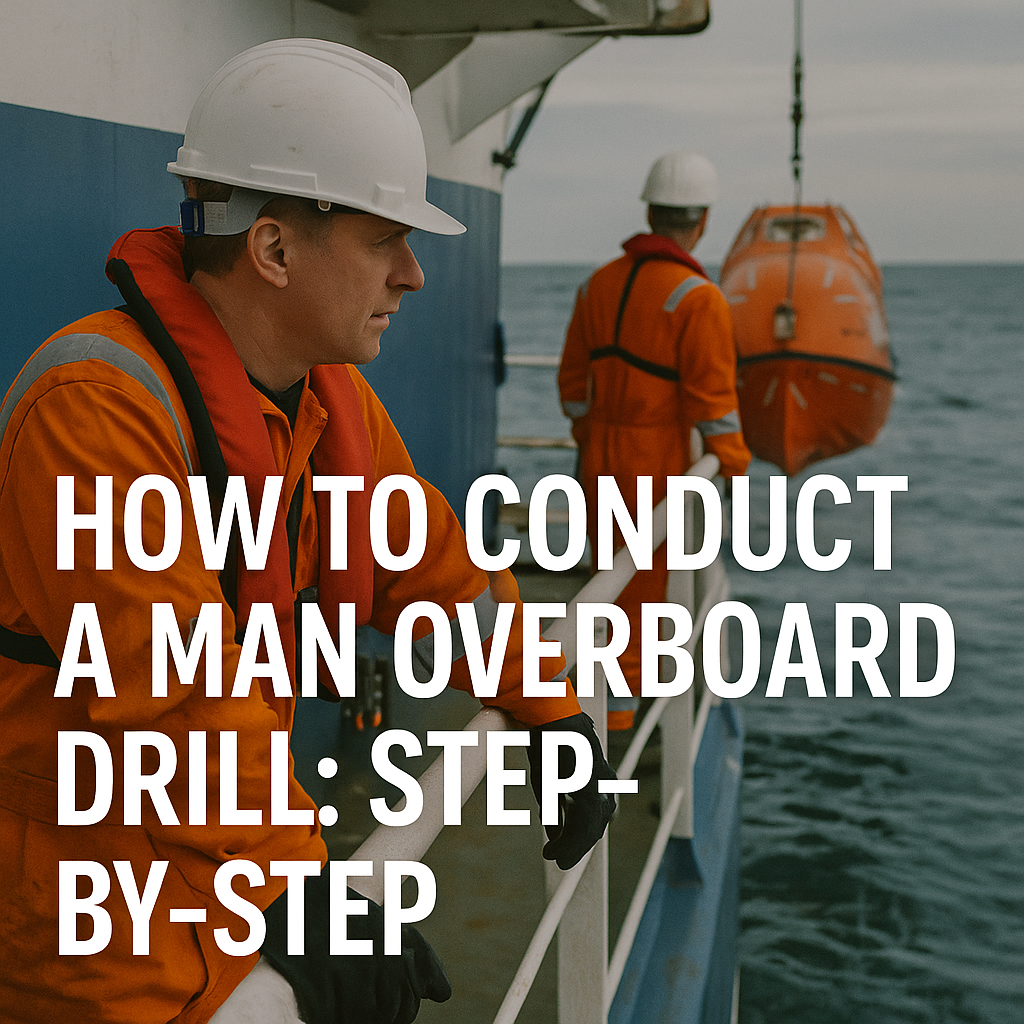Learn how to conduct a man overboard drill step-by-step, following STCW and SOLAS standards. This comprehensive guide supports training officers with MOB checklists, real examples, and safety tips.
Why Man Overboard Drills Matter in Modern Maritime Operations
There are few moments onboard a vessel more urgent or emotionally charged than a man overboard (MOB) alarm. In those first 60 seconds, your crew’s training—or lack of it—can mean the difference between a life saved or a life lost. According to the International Maritime Organization (IMO), man overboard incidents remain one of the most common emergency scenarios on commercial ships.
This is where regular MOB drills come in—not just as a compliance task but as a lifeline rehearsal. Drills are essential in meeting the Standards of Training, Certification and Watchkeeping (STCW) and SOLAS Chapter III requirements, but more importantly, they train officers and crew to respond instinctively in a crisis. A well-conducted drill helps build confidence, coordination, and familiarity with rescue equipment, from lifebuoys to fast rescue boats.
For training officers, the goal is not to tick a box on a safety checklist but to simulate a scenario that feels real. That’s why this guide walks you through how to conduct a MOB drill step by step—with technical accuracy and a human touch.

Regulatory Framework: SOLAS and STCW Requirements
Under SOLAS Regulation III/19, all ships must carry out emergency drills—including MOB drills—at least once every month. The STCW Code (Table A-VI/1-2) further specifies the required competencies for personal survival techniques, which include reacting to man overboard emergencies.
Additional requirements:
- Drills must be recorded in the ship’s logbook.
- Drills should involve launching a rescue boat (if conditions allow).
- Equipment (lifebuoys, beacons, lights) must be inspected before and after the drill.
These standards are enforced during Port State Control (PSC) inspections and company audits by classification societies such as DNV, BV, or ClassNK.
Pre-Drill Preparation: Setting the Stage for Success
Before initiating a drill, the training officer must carry out a thorough planning phase to ensure safety and educational value.
1. Inform and Brief the Crew
While surprise drills can test reflexes, it’s best to inform the crew in advance—especially if rescue boats will be deployed. Brief each team (bridge, deck, engine room, rescue crew) on their roles.
2. Check Weather and Sea Conditions
Safety is non-negotiable. Conduct drills only in conditions that do not risk injury or vessel control.
3. Inspect Equipment
Ensure lifebuoys, MOB markers, rescue boats, radios, and immersion suits are in working order. Confirm the MOB GPS button is functional.
4. Assign Observers
Designate senior officers or safety auditors to take notes and observe response times.
5. Prepare Dummy or Marker
Use a weighted dummy or floating object to simulate the person overboard. Attach a beacon or marker buoy for visibility.
Step-by-Step: Conducting the Man Overboard Drill
Here’s a structured sequence for conducting an effective MOB drill:
Step 1: Initiate the MOB Scenario
Trigger the drill using a verbal call—”Man overboard, starboard side!”—followed by pressing the MOB button on the GPS or ECDIS system. This action should mark the coordinates.
Step 2: Sound the General Alarm
Activate the general alarm or MOB-specific signal. Announce the emergency over the PA system and alert all crew.
Step 3: Deploy Visual Aids
Throw lifebuoys with self-igniting lights and smoke signals into the water. This simulates the real visibility challenges in a live MOB scenario.
Step 4: Execute Navigation Maneuver
The Officer of the Watch (OOW) performs a Williamson turn, Anderson turn, or Scharnow turn depending on the ship’s maneuvering characteristics.
Step 5: Launch the Rescue Boat
Upon receiving permission from the bridge and confirming safe conditions, the rescue team launches the boat. They should carry:
- Handheld radio
- Thermal binoculars or IR scope
- First aid kit
- Life ring and heaving line
Step 6: Retrieve the Dummy
The rescue team approaches from downwind and uses recovery techniques as per the vessel’s Safety Management System (SMS). Once retrieved, the dummy is brought back onboard and medically “assessed.”
Step 7: Debrief and Log
Conduct a debrief session immediately. Discuss response times, coordination gaps, and improvement points. Record all actions and observations in the GMDSS logbook and Safety Drill Record Book.
–
Common Pitfalls in MOB Drills
Even experienced crews can fall short if the drill is poorly planned. Common mistakes include:
- Failing to mark the MOB location on GPS or ECDIS.
- Inadequate communication between bridge and rescue team.
- Late deployment of rescue assets, reducing realism.
- Skipping debriefs, which are essential for learning.
- Treating the drill casually, reducing its effectiveness.
–
Enhancing Realism: Making Drills More Effective
To make drills more impactful, consider adding realistic elements:
Night Drills: Use handheld searchlights and IR gear to simulate nighttime MOB recovery.
Multi-Role Scenarios: Include engine room standby for potential propulsion loss or medical team simulation for hypothermia treatment.
AIS Beacon Use: Equip the dummy with an AIS MOB device to test bridge team tracking abilities.
Environmental Challenges: Simulate rough weather or limited visibility using foghorns or blackout goggles (if safe).
–
Case Example: Tanker Vessel in the Gulf (2023)
A chemical tanker conducted a full MOB drill with rescue boat deployment in the Gulf of Oman. Key actions included:
- MOB call issued at 09:12.
- MOB button marked coordinates within 10 seconds.
- Lifebuoy with smoke deployed.
- FRC launched and dummy recovered in 5 minutes.
- Bridge maintained VHF contact throughout.
Observers from ClassNK reported excellent coordination and recommended this model be used for training in other fleet vessels. The captain noted that “frequent MOB drills have made our crew sharp, not just compliant.”
The Role of Classification Societies and Auditors
Entities like Lloyd’s Register, DNV, and RINA often attend drills during audits or vessel inspections. They focus on:
- Crew readiness and response time
- Proper use of equipment
- Compliance with SMS procedures
- Post-drill analysis and documentation
Failure to conduct adequate drills is frequently cited in Port State Control (PSC) deficiencies under the Paris MoU and Tokyo MoU annual reports.
Future Developments in MOB Training
VR Training Modules: Several maritime academies and training providers (e.g., Massachusetts Maritime Academy, Thetius) are integrating virtual reality to simulate MOB scenarios with stress and urgency.
Wearable Alert Systems: Crew members now wear smart lifejackets with immersion sensors that trigger onboard MOB alarms.
Bridge Automation Integration: Future ECDIS systems will automatically initiate a recovery pattern when a MOB signal is received.
AI-Assisted Debriefs: Some companies are using AI software to analyze drill recordings and generate performance heatmaps for training officers.
FAQs
How often should man overboard drills be conducted?
At least once a month, as per SOLAS Regulation III/19. More frequent drills are recommended on high-risk routes.
Is it mandatory to launch a rescue boat during drills?
Yes, if weather and sea conditions permit. Otherwise, simulate the procedure and document why actual launching wasn’t possible.
Can MOB drills be combined with other drills?
Yes. MOB drills can be integrated into abandon ship or fire drills, but must maintain clear training objectives.
What is the MOB button on the bridge used for?
It marks the ship’s GPS position at the time of the fall, assisting navigation back to the incident location.
Are MOB drills required during port stays?
It is allowed but not ideal. Drills should be done at sea to simulate real movement, distance, and vessel maneuvering.
What records must be kept?
Log entries should include date, time, scenario summary, equipment used, crew involved, and debrief outcomes.
Conclusion
A man overboard drill is more than a compliance item; it is a life-saving rehearsal that sharpens your crew’s instincts and coordination. As a training officer, your role is pivotal in making that drill realistic, informative, and actionable.
Incorporate real-world challenges. Encourage honest feedback. Engage the crew with purpose, not just protocol. Because when someone falls into the sea, the minutes that follow are critical.
Training saves lives. And it starts with a drill that feels real.
References
- IMO. (2024). SOLAS Consolidated Edition. https://www.imo.org
- STCW Code. (2023). Standards of Training, Certification and Watchkeeping for Seafarers. https://www.imo.org
- EMSA. (2023). Annual Overview of Maritime Safety. https://emsa.europa.eu
- DNV. Man Overboard Training Guide. https://www.dnv.com
- Wärtsilä Safety Systems. https://www.wartsila.com
- Paris MoU Port State Control. https://www.parismou.org
- The Nautical Institute. https://www.nautinst.org
- Thetius Maritime Training Tech. https://www.thetius.com

